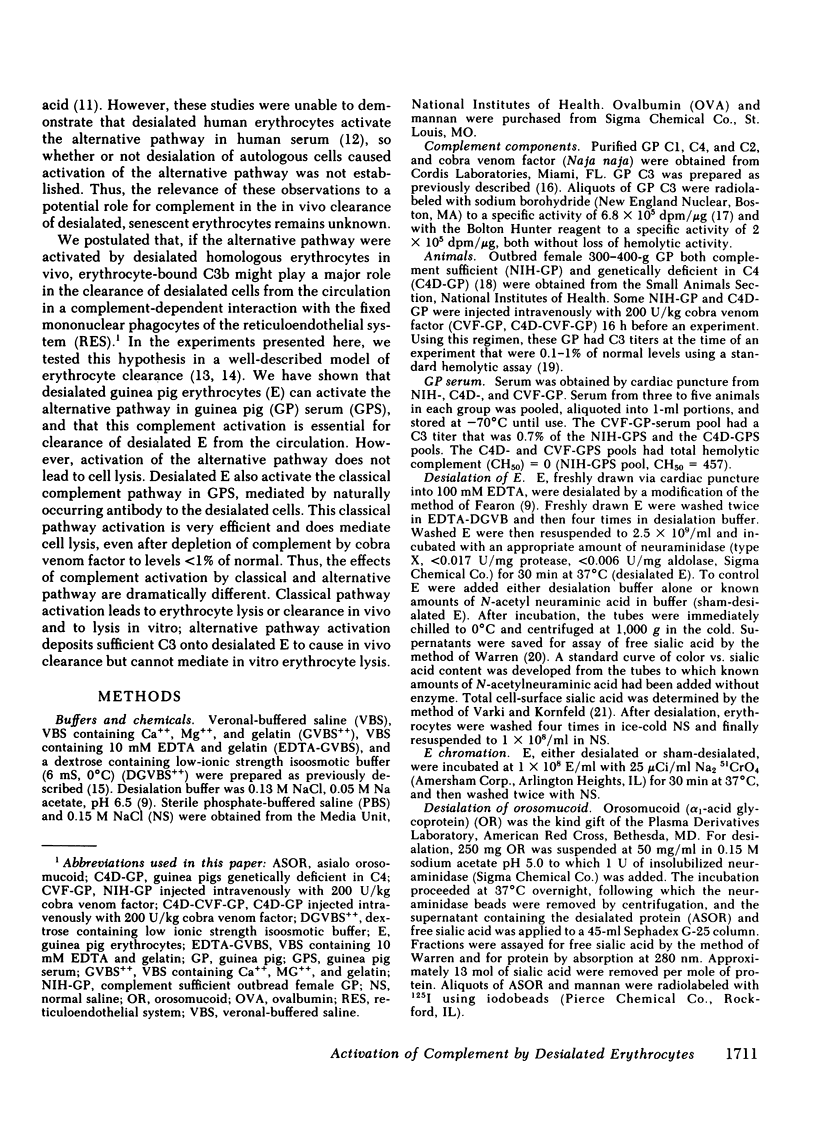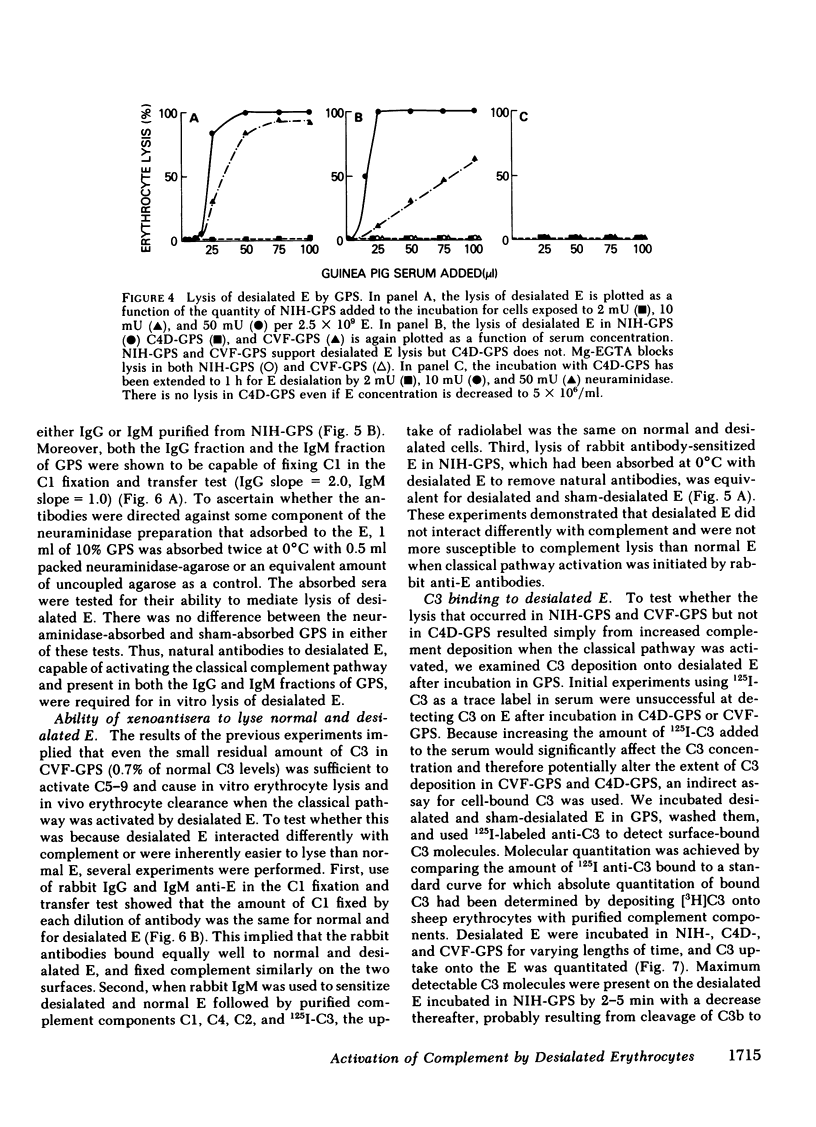Abstract
We examined the fate of desialated autologous erythrocytes injected intravenously into guinea pigs (GP). Desialated GP erythrocytes (E) were lysed directly or cleared by the reticuloendothelial system in normal GP (NIH-GP) and cleared by the reticuloendothelial system in GP genetically deficient in the classical complement pathway component C4 (C4D-GP), which activate complement only via the alternative pathway. Desialated E were also cleared in cobra venom factor-treated GP (CVF-GP), which had less than 1% of normal C3 levels, but were not cleared at all in C4D-CVF-GP. Preinjection of asialoorosomucoid (ASOR) and ovalbumin (OVA) had no effect on the rate of E clearance. These in vivo studies indicated that complement activation is essential for clearance of desialated E and that clearance is unaffected by blockade of galactose or mannose receptors. Inhibition of complement-mediated clearance required blockade of both classical and alternative complement pathways. In vitro studies showed that lysis of desialated E could occur in NIH-GP serum (GPS) but not in C4D-GPS. Surprisingly, CVF-GPS also caused lysis of desialated E. Lysis was dependent on both natural antibody to desialated E and classical pathway activation; natural antibody was of both the IgG and IgM classes. C3 uptake studies demonstrated that almost 10 times as many C3 molecules/E were deposited by NIH-GPS as by C4D-GPS or CVF-GPS onto desialated E. Approximately equal numbers of C3 molecules were deposited by CVF-GPS, which did lyse desialated E, and by C4D-GPS, which did not. We suggest that the molecular mechanism of in vivo clearance and in vitro lysis of desialated E by CVF-GP is via classical pathway deposition of C3b into sites on the erythrocyte surface protected from inactivation by H (beta 1H) and I (C4b/3b inactivator). Deposition of C3b into these sites by alternative pathway activation is sufficient to cause clearance but not lysis of desialated E. CVF-GPS may not represent an adequate reagent for testing the complement dependence of various biologic phenomena, particularly if the question involves surfaces that can provide protected sites for C3b molecules.
Full text
PDF









Selected References
These references are in PubMed. This may not be the complete list of references from this article.
- Ashwell G., Morell A. G. The role of surface carbohydrates in the hepatic recognition and transport of circulating glycoproteins. Adv Enzymol Relat Areas Mol Biol. 1974;41(0):99–128. doi: 10.1002/9780470122860.ch3. [DOI] [PubMed] [Google Scholar]
- Baxter A., Beeley J. G. Surface carbohydrates of aged erythrocytes. Biochem Biophys Res Commun. 1978 Jul 28;83(2):466–471. doi: 10.1016/0006-291x(78)91013-6. [DOI] [PubMed] [Google Scholar]
- Baynes J. W., Wold F. Effect of glycosylation on the in vivo circulating half-life of ribonuclease. J Biol Chem. 1976 Oct 10;251(19):6016–6024. [PubMed] [Google Scholar]
- Borsos T., Rapp H. J. Hemolysin titration based on fixation of the activated first component of complement: evidence that one molecule of hemolysin suffices to sensitize an erythrocyte. J Immunol. 1965 Sep;95(3):559–566. [PubMed] [Google Scholar]
- Bray J., Lemieux R. U., McPherson T. A. Use of a synthetic hapten in the demonstration of the Thomsen-Friedenreich (T) antigen on neuraminidase-treated human red blood cells and lymphocytes. J Immunol. 1981 May;126(5):1966–1969. [PubMed] [Google Scholar]
- Brown E. J. An improved method for performance of the C1 fixation and transfer test. J Immunol Methods. 1982 Nov 26;55(1):115–122. doi: 10.1016/0022-1759(82)90084-9. [DOI] [PubMed] [Google Scholar]
- Brown E. J., Hosea S. W., Hammer C. H., Burch C. G., Frank M. M. A quantitative analysis of the interactions of antipneumococcal antibody and complement in experimental pneumococcal bacteremia. J Clin Invest. 1982 Jan;69(1):85–98. doi: 10.1172/JCI110444. [DOI] [PMC free article] [PubMed] [Google Scholar]
- Clas F., Loos M. Antibody-independent binding of the first component of complement (C1) and its subcomponent C1q to the S and R forms of Salmonella minnesota. Infect Immun. 1981 Mar;31(3):1138–1144. doi: 10.1128/iai.31.3.1138-1144.1981. [DOI] [PMC free article] [PubMed] [Google Scholar]
- Daha M. R., Fearon D. T., Austen K. F. C3 requirements for formation of alternative pathway C5 convertase. J Immunol. 1976 Aug;117(2):630–634. [PubMed] [Google Scholar]
- Ellman L., Green I., Frank M. Genetically controlled total deficiency of the fourth component of complement in the guinea pig. Science. 1970 Oct 2;170(3953):74–75. doi: 10.1126/science.170.3953.74. [DOI] [PubMed] [Google Scholar]
- Fearon D. T., Austen K. F. Activation of the alternative complement pathway due to resistance of zymosan-bound amplification convertase to endogenous regulatory mechanisms. Proc Natl Acad Sci U S A. 1977 Apr;74(4):1683–1687. doi: 10.1073/pnas.74.4.1683. [DOI] [PMC free article] [PubMed] [Google Scholar]
- Fearon D. T. Regulation by membrane sialic acid of beta1H-dependent decay-dissociation of amplification C3 convertase of the alternative complement pathway. Proc Natl Acad Sci U S A. 1978 Apr;75(4):1971–1975. doi: 10.1073/pnas.75.4.1971. [DOI] [PMC free article] [PubMed] [Google Scholar]
- Fearon D. T. Regulation of the amplification C3 convertase of human complement by an inhibitory protein isolated from human erythrocyte membrane. Proc Natl Acad Sci U S A. 1979 Nov;76(11):5867–5871. doi: 10.1073/pnas.76.11.5867. [DOI] [PMC free article] [PubMed] [Google Scholar]
- Finbloom D. S., Magilavy D. B., Harford J. B., Rifai A., Plotz P. H. Influence of antigen on immune complex behavior in mice. J Clin Invest. 1981 Jul;68(1):214–224. doi: 10.1172/JCI110238. [DOI] [PMC free article] [PubMed] [Google Scholar]
- Gaither T. A., Hammer C. H., Frank M. M. Studies of the molecular mechanisms of C3b inactivation and a simplified assay of beta 1H and the C3b inactivator (C3bINA). J Immunol. 1979 Sep;123(3):1195–1204. [PubMed] [Google Scholar]
- Hudgin R. L., Pricer W. E., Jr, Ashwell G., Stockert R. J., Morell A. G. The isolation and properties of a rabbit liver binding protein specific for asialoglycoproteins. J Biol Chem. 1974 Sep 10;249(17):5536–5543. [PubMed] [Google Scholar]
- Janicik J. M., Schauer R., Andres K. H., von Düring M. Sequestration of neuraminidase-treated erythrocytes. Studies on its topographic, morphologic and immunologic aspects. Cell Tissue Res. 1978 Jan 17;186(2):209–226. doi: 10.1007/BF00225532. [DOI] [PubMed] [Google Scholar]
- Kolb H., Kriese A., Kolb-Bachofen V., Kolb H. A. Possible mechanism of entrapment of neuraminidase-treated lymphocytes in the liver. Cell Immunol. 1978 Oct;40(2):457–462. doi: 10.1016/0008-8749(78)90355-6. [DOI] [PubMed] [Google Scholar]
- Kolb H., Schudt C., Kolb-Bachofen V., Kolb H. A. Cellular recognition by rat liver cells of neuraminidase-treated erythrocytes. Demonstration and analysis of cell contacts. Exp Cell Res. 1978 May;113(2):319–325. doi: 10.1016/0014-4827(78)90372-5. [DOI] [PubMed] [Google Scholar]
- Lambré C. R., Kazatchkine M. D., Maillet F., Thibon M. Guinea pig erythrocytes, after their contact with influenza virus, acquire the ability to activate the human alternative complement pathway through virus-induced desialation of the cells. J Immunol. 1982 Feb;128(2):629–634. [PubMed] [Google Scholar]
- Moore F. D., Jr, Austen K. F., Fearon D. T. Antibody restores human alternative complement pathway activation by mouse erythrocytes rendered functionally deficient by pretreatment with pronase. J Immunol. 1982 Mar;128(3):1302–1306. [PubMed] [Google Scholar]
- Nelson B., Ruddy S. Enhancing role of IgG in lysis of rabbit erythrocytes by the alternative pathway of human complement. J Immunol. 1979 May;122(5):1994–1999. [PubMed] [Google Scholar]
- Nydegger U. E., Fearon D. T., Austen K. F. Autosomal locus regulates inverse relationship between sialic acid content and capacity of mouse erythrocytes to activate human alternative complement pathway. Proc Natl Acad Sci U S A. 1978 Dec;75(12):6078–6082. doi: 10.1073/pnas.75.12.6078. [DOI] [PMC free article] [PubMed] [Google Scholar]
- Pangburn M. K., Müller-Eberhard H. J. Complement C3 convertase: cell surface restriction of beta1H control and generation of restriction on neuraminidase-treated cells. Proc Natl Acad Sci U S A. 1978 May;75(5):2416–2420. doi: 10.1073/pnas.75.5.2416. [DOI] [PMC free article] [PubMed] [Google Scholar]
- Pfannschmidt G., Schauer R. The role of membrane sialyl and galactosyl residues in regulation of the life-time of rabbit erythrocytes. Hoppe Seylers Z Physiol Chem. 1980 Nov;361(11):1683–1695. doi: 10.1515/bchm2.1980.361.2.1683. [DOI] [PubMed] [Google Scholar]
- Schreiber A. D., Frank M. M. Role of antibody and complement in the immune clearance and destruction of erythrocytes. I. In vivo effects of IgG and IgM complement-fixing sites. J Clin Invest. 1972 Mar;51(3):575–582. doi: 10.1172/JCI106846. [DOI] [PMC free article] [PubMed] [Google Scholar]
- Schreiber A. D., Frank M. M. Role of antibody and complement in the immune clearance and destruction of erythrocytes. II. Molecular nature of IgG and IgM complement-fixing sites and effects of their interaction with serum. J Clin Invest. 1972 Mar;51(3):583–589. doi: 10.1172/JCI106847. [DOI] [PMC free article] [PubMed] [Google Scholar]
- Steer C. J., James S. P., Vierling J. M., Hosea S. W., Jones E. A. The selective hepatic uptake of desialylated peripheral blood mononuclear cells in rabbits. Gastroenterology. 1980 Nov;79(5 Pt 1):917–923. [PubMed] [Google Scholar]
- Steinbuch M., Audran R. The isolation of IgG from mammalian sera with the aid of caprylic acid. Arch Biochem Biophys. 1969 Nov;134(2):279–284. doi: 10.1016/0003-9861(69)90285-9. [DOI] [PubMed] [Google Scholar]
- Theofilopoulos A. N., Perrin L. H. Lysis of human cultured lymphoblastoid cells by cell-induced activation of the properdin pathway. Science. 1977 Mar 4;195(4281):878–880. doi: 10.1126/science.402691. [DOI] [PubMed] [Google Scholar]
- Thornburg R. W., Day J. F., Baynes J. W., Thorpe S. R. Carbohydrate-mediated clearance of immune complexes from the circulation. A role for galactose residues in the hepatic uptake of IgG-antigen complexes. J Biol Chem. 1980 Jul 25;255(14):6820–6825. [PubMed] [Google Scholar]
- Varki A., Kornfeld S. An autosomal dominant gene regulates the extent of 9-O-acetylation of murine erythrocyte sialic acids. A probable explanation for the variation in capacity to activate the human alternate complement pathway. J Exp Med. 1980 Sep 1;152(3):532–544. doi: 10.1084/jem.152.3.532. [DOI] [PMC free article] [PubMed] [Google Scholar]
- WARREN L. The thiobarbituric acid assay of sialic acids. J Biol Chem. 1959 Aug;234(8):1971–1975. [PubMed] [Google Scholar]


